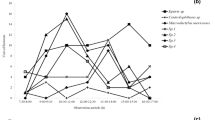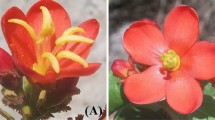Abstract
Florivory and floral larceny are very common antagonistic interactions in nature. Florivory can be especially harmful to species with polymorphisms because it may hinder the transfer of pollen in one of the floral morphs. Flower size is one of the floral signals that can influence the attraction of these antagonists. In addition, little is known about the effects of florivory on other antagonistic interactions. Thus, the objective of this study was to investigate the natural patterns of florivory and the relationship between florivory and robbery in the attraction of larcenists in the species Senna rugosa. All flowers damaged by florivores were collected for measurement of natural patterns of florivory with aid of the ImageJ software. Florivory were simulated by holes in the base of the petals and photographs and focal observations were made to assess the effect of flower area and florivory on the attraction of floral larcenists. Smaller flowers had higher florivory rates. In larger flowers, the inner part of the corolla and the anthers had a greater probability of suffering florivory. Although the damage caused by florivory occurred discontinuously regardless of flower size, larger flowers presented continuous marks of florivory more frequently than smaller ones. Larcenists visited flowers regardless of flower size or damaged parts. Thus, flower size and florivory are not determinant factors for the attraction of floral larcenists in enantiostylous S. rugosa.



Similar content being viewed by others
References
Almeida NM, Bezerra TT, Oliveira CRS et al (2015a) Breeding systems of enantiostylous Cassiinae species (Fabaceae, Caesalpinioideae). Flora Morphol Distrib Funct Ecol Plants 215:9–15. https://doi.org/10.1016/j.flora.2015.06.003
Almeida NM, Cotarelli VM, Souza DP et al (2015b) Enantiostylous types of Cassiinae species (Fabaceae-Caesalpinioideae). Plant Biol 17:740–745. https://doi.org/10.1111/plb.12283
Almeida NM, Siqueira Filho JA, Oliveira PE et al (2016) Bicarpellate gynoecium in two species of Senna (Fabaceae, Caesalpinioidae, Cassiinae). Acta Bot Brasilica 30:326–328. https://doi.org/10.1590/0102-33062016abb0106
Amorim TM, Soares AA, Westerkamp C (2019) More on Buzz Pollination- Pollen Rebounds in Asymmetric Flowers. In: Bahadur B, Krishnamurthy KV, Ghose M, Adams SJ. Asymmetry in plants: Biology of handedness 1a ed. CRC Press, pp 333–354
Andersson S (1994) Floral stability, pollination efficiency, and experimental manipulation of the corolla phenotype in Nemophila menziesii (Hydrophyllaceae). Am J Bot 81:1397–1402. https://doi.org/10.1002/j.1537-2197.1994.tb15624.x
Arista M, Ortiz PL (2007) Differential gender selection on floral size: an experimental approach using Cistus salvifolius. Jounal Ecol 95:973–982. https://doi.org/10.1111/j.1365-2745.2007.01276.x
Barrett SCH (2002) The evolution of plant sexual diversity. Nat Rev Genet 3:274–284. https://doi.org/10.1038/nrg776
Bell G (1985) On the function of flowers. Proc - R Soc London, Ser B 224:223–265. https://doi.org/10.1098/rspb.1985.0031
Bezerra FWP (2004) Plano de Manejo da Floresta Nacional do Araripe
Briscoe AD, Chittka L (2001) The evolution of color vision in insects. Annu Rev Entomol 46:471–510
Brito VLG, Leite FB, Telles FJ et al (2020) The attractive role of floral elements in heterantherous species without pronounced stamen differences. Arthropod Plant Interact. https://doi.org/10.1007/s11829-020-09794-1
Buchmann SL, Hurley JP (1978) A biophysical model for buzz pollination in angiosperms. J Theor Biol 72:639–657. https://doi.org/10.1016/0022-5193(78)90277-1
Cardoso JCF, Viana ML, Matias R et al (2018) Towards a unified terminology for angiosperm reproductive system. Acta Bot Brasilica 32:329–348. https://doi.org/10.1590/0102-33062018abb0124
Camargo MGG, Lunau K, Batalha MA et al (2019) How flower colour signals allure bees and hummingbirds: a community-level test of the bee avoidance hypothesis. New Phytol 222:1112–1122. https://doi.org/10.1111/nph.15594
Costa IR, Araújo FS (2007) Organização comunitária de um encrave de cerrado sensu stricto no bioma Caatinga, chapada do Araripe, Barbalha, Ceará. Acta Bot Brasilica 21:281–291. https://doi.org/10.1590/s0102-33062007000200004
Cotarelli VM, De Almeida ANM (2015) Florivoria em Senna macranthera var. pudibunda (Benth.) H.S.Irwin & Barneby (Caesalpinioideae-Fabaceae). Nat Line 13:45–49
Cotarelli VM, Vieira AOS (2009) Herbivoria floral em Chamaecrista trachycarpa (Vog.) H.S. Irwin & Barneby, em uma área de campo natural (Telêmaco Borba, Pr, Brasil). Semin Ciências Biológicas e Da Saúde 30:91–98. https://doi.org/10.5433/1679-0367.2009v30n1p91
D’arcy WG, Keating RC (1996) The anther: form, function and phylogeny. Cambridge University Press, 1996.
Dafni A, Kevan PG, Husband BC (2005) Practical pollination biology. University of Haifa, Haifa, Institute of Evolution
Dantas MM, Silva MJ (2013) O gênero Senna Mill. (Leguminosae, Caesalpinioideae, Cassieae) no Parque Estadual da Serra Dourada, GO. Brasil Hoehnea 40:99–113
De Almeida ANM, de Castro CC, Leite AVDL et al (2013) Enantiostyly in Chamaecrista ramosa (Fabaceae- Caesalpinioideae): floral morphology, pollen transfer dynamics and breeding system. Plant Biol 15:369–375. https://doi.org/10.1111/j.1438-8677.2012.00651.x
Esmeraldo ACC, Albuquerque BLM, Costa MAC (2011) A importância da conservação/preservação ambiental da floresta nacional do araripe para a região do cariri – Ceará/Brasil. Rev Geográfica América Cent 7:1–10
Freitas L (2018) Precisamos falar sobre o uso impróprio de recursos florais. Rodriguesia 69:2223–2228. https://doi.org/10.1590/2175-7860201869446
Galen C (1999) Do Flowers Vary? the functional ecology of variation in flower size and form within natural plant populations Candace. Bioscience 49:631–640
Glaum P, Kessler A (2017) Functional reduction in pollination through herbivore-induced pollinator limitation and its potential in mutualist communities. Nat Commun 8:1–10. https://doi.org/10.1038/s41467-017-02072-4
Gómez JM (2003) Herbivory reduces the strength of pollinator-mediated selection in the Mediterranean herb erysimum mediohispanicum : consequences for plant specialization. Am Nat 162:242–256
Gómez JM (2008) Sequential conflicting selection due to multispecific interactions triggers evolutionary trade-offs in a monocarpic Herb. Evolution (NY) 62:668–669. https://doi.org/10.1111/j.1558-5646.2007.00312.x
González-Becerril AA (2011) Morfología del androceo de Solanum rostratum (Solanaceae) y presentación de polen en anteras dimórficas. Bacherol thesis, Facultad de Ciencias, UNAM.
Gorden NL, Adler LS (2016) Florivory shapes both leaf and floral interactions. Ecosphere 7:1–15. https://doi.org/10.1002/ecs2.1326
Gotelli NJ, Ellison AM (2011) Princípios de estatística em ecologia. Artmed Editora
Gottsberger G, Silberbauer-Gottsberger I (1988) Evolution of flower structures and pollination in neotropical cassiinae (caesalpiniaceae) species. Phyt 28:293–320
Gronquist M, Bezzerides A, Attygalle A et al (2001) Attractive and defensive functions of the ultraviolet pigments of a flower (Hypericum calycinum). Proc Natl Acad Sci U S A 98:13745–13750. https://doi.org/10.1073/pnas.231471698
Hargreaves AL, Harder LD, Johnson SD (2009) Consumptive emasculation: the ecological and evolutionary consequences of pollen theft. Biol Rev 84:259–276. https://doi.org/10.1111/j.1469-185X.2008.00074.x
Irwin HS, Barneby RC (1982a) The American Cassinae. Bronx, New York
Irwin HS, Barneby RS (1982b) The American cassiinaea synoptical revision of leguminosae tribe cassieae subtribe cassiinae in the New World. New York Botanical Garden Bronx, New York
Irwin RE, Adler LS, Brody AK (2004) The dual role of floral traits: pollinator attraction and plant defense. Ecology 85:1503–1511
Jesson LK, Barrett SCH (2002) Enantiostyly: solving the puzzle of mirror-image flowers. Nature 417:707. https://doi.org/10.1038/417707a
Johnson MTJ, Campbell SA, Barrett SCH (2015) Evolutionary interactions between plant reproduction and defense against herbivores. Annu Rev 46:191–213. https://doi.org/10.1146/annurev-ecolsys-112414-054215
Karban R, Strauss SY (1993) Effects of herbivores on growth and reproduction of their perennial host, Erigeron glaucus. Ecology 74:39–46. https://doi.org/10.2307/1939499
Kessler D, Diezel C, Clark DG et al (2013) Petunia flowers solve the defence/apparency dilemma of pollinator attraction by deploying complex floral blends. Ecol Lett 16:299–306. https://doi.org/10.1111/ele.12038
Kirk WDJ, Ali M, Breadmore KN (1995) The effects of pollen beetles on the foraging behaviour of honey bees. J Apic Res 34:15–22. https://doi.org/10.1080/00218839.1995.11100881
Knauer AC, Schiestl FP (2017) The effect of pollinators and herbivores on selection for floral signals : a case study in Brassica rapa. Evol Ecol 31:285–304. https://doi.org/10.1007/s10682-016-9878-8
Kozlov MV, Lanta V, Zverev V, Zvereva EL (2015) Background losses of woody plant foliage to insects show variable relationships with plant functional traits across the globe. J Ecol 103:1519–1528. https://doi.org/10.1111/1365-2745.12471
Land MF, Nilsson D-E (2002) Animal eyes. Exp Clin Psychopharmacol 1:271. https://doi.org/10.1037/1064-1297.1.1-4.173
Liao K, Gituru RW, Guo YH, Wang QF (2013) Effects of floral herbivory on foraging behaviour of bumblebees and female reproductive success in Pedicularis gruina (Orobanchaceae). Flora Morphol Distrib Funct Ecol Plants 208:562–569. https://doi.org/10.1016/j.flora.2013.08.007
Lunau K (2000) The ecology and evolution of visual pollen signals. Plant Syst Evol 222:89–111. https://doi.org/10.1007/BF00984097
Lunau K, Konzmann S, Winter L et al (2017) Pollen and stamen mimicry: the alpine flora as a case study. Arthropod Plant Interact 11:427–447. https://doi.org/10.1007/s11829-017-9525-5
Luo Z, Zhang D, Renner SS (2008) Why two kinds of stamens in buzz-pollinated flowers? experimental support for Darwin’s division-of-labour hypothesis. Funct Ecol 22:794–800. https://doi.org/10.1111/j.1365-2435.2008.01444.x
Malo JE, Leirana-Alcocer J, Parra-Tabla V (2001) Population fragmentation, florivory, and the effects of flower morphology alterations on the pollination success of myrmecophila tibicinis (orchidaceae). Biotropica 33:529–534. https://doi.org/10.1111/j.1744-7429.2001.tb00207.x
Marazzi B, Conti E, Endress PK (2007) Diversity in anthers and stigmas in the buzz - pollinated genus senna ( leguminosae, cassiinae ). Int J Plant Sci 168:371–391
Martins AE, Gélvez-Zúniga I, Queiroz SNP, Paiva B (2018) Flower attractiness traits are affected differently by florivores in Tibouchina clavata (Pers.) Wurdack. In: Annals of the XII International Pollination Course. pp 23–30
McCall AC (2008) Florivory affects pollinator visitation and female fitness in Nemophila menziesii. Oecologia 155:729–737. https://doi.org/10.1007/s00442-007-0934-5
Mccall AC, Barr CM (2012) Why do forivores prefer hermaphrodites over females in Nemophila menziesii (Boraginaceae)? Oecologia 170:147–157. https://doi.org/10.1007/s00442-012-2278-z
McCall AC, Irwin RE (2006) Florivory: The intersection of pollination and herbivory. Ecol Lett 9:1351–1365. https://doi.org/10.1111/j.1461-0248.2006.00975.x
Mendonça LAR, Frischkorn H, Santiago MF et al (2010) Identificação de mudanças florestais por 13C e 15N dos solos da Chapada do Araripe, Ceará. Rev Bras Eng Agric e Ambient 14:314–319. https://doi.org/10.1590/s1415-43662010000300012
Mothershead K, Marquis RJ (2000) Fitness impacts of herbivory through indirect effects on plant-pollinator interactions in Oenothera macrocarpa. Ecology 81:30–40. https://doi.org/10.1890/0012-9658(2000)081[0030:fiohti]2.0.co;2
Muola A, Weber D, Malm LE et al (2017) Direct and pollinator-mediated effects of herbivory on strawberry and the potential for improved resistance. Front Plant Sci 8:1–10. https://doi.org/10.3389/fpls.2017.00823
Nascimento EA, Del-Claro K (2007) Floral Visitors of Chamaecrista debilis (Vogel) Irwin & Barneby (Fabaceae - Caesalpinioideae) at Cerrado of Estação Ecológica de Jataí, São Paulo State, Brazil. Ecol Modell 134:275–282. https://doi.org/10.1016/S0304-3800(00)00352-5
Ollerton J, Winfree R, Tarrant S (2011) How many flowering plants are pollinated by animals? Oikos 120:321–326. https://doi.org/10.1111/j.1600-0706.2010.18644.x
Pinheiro-Costa BK, Mesquita-Neto JN, Rego JO, Schlindwein C (2018) Trade off between quantity and size of pollen grains in the heterandrous flowers of Senna pendula (Fabaceae). Acta Bot Brasilica 32:446–453. https://doi.org/10.1590/0102-33062018abb0132
Ribeiro JF, Walter T (1998) Fitofisionomias do bioma Cerrado. Embrapa Cerrados - Capítulo em livro científico 89–166
Ribeiro RA, Lovato MB (2004) Mating system in a neotropical tree species, Senna multijuga (Fabaceae). Genet Mol Biol 27:418–424. https://doi.org/10.1590/S1415-47572004000300018
Russell AL, Golden RE, Leonard AS, Papaj DR (2016) Bees learn preferences for plant species that offer only pollen as a reward. Behav Ecol 27:731–740. https://doi.org/10.1093/beheco/arv213
Santos JP (2013) O gênero Senna Mill. (Leguminosae, Caesalpinoideae, Cassinae) na região Centro-Oeste do Brasil, com ênfase nas espécies ocorrentes no estado de Goiás. Masters dissertation, Universidade Federal de Goiás
Santos TT, Oliveira ACS, Queiroz RB, Silva JS (2020) O gênero Senna (Leguminosae-Caesalpinioidea) no município de Caetité, Bahia. Brasil Rodriguesia. https://doi.org/10.1590/2175-7860202071002
Schiestl FP (2015) Ecology and evolution of floral volatile-mediated information transfer in plants. New Phytol 206:571–577. https://doi.org/10.1111/nph.13243
Schiestl FP, Johnson SD (2013) Pollinator-mediated evolution of floral signals. Trends Ecol Evol 28:307–315. https://doi.org/10.1016/j.tree.2013.01.019
Scogin R, Young DA, Jones CE (1977) Anthochlor pigments and pollination biology. II. The ultraviolet floral pattern of Coreopsis gigantea (Asteraceae). Bull Torrey Bot Club 104:155. https://doi.org/10.2307/2484361
Sletvold N (2019) The context dependence of pollinator-mediated selection in natural populations. Int J Plant Sci 180:934–943. https://doi.org/10.1086/705584
Solís-Montero L, Vergara CH, Vallejo-Marín M (2015) High incidence of pollen theft in natural populations of a buzz-pollinated plant. Arthropod Plant Interact 9:599–611. https://doi.org/10.1007/s11829-015-9397-5
Strauss SY, Conner JK, Lehtilä KP (2001) Effects of foliar herbivory by insects on the fitness of Raphanus raphanistrum: damage can increase male fitness. Am Nat 158:496–504. https://doi.org/10.1086/323116
Torezan-Silingardi HM (2007) A influência dos herbívoros dos polinizadores e das características fenológicas sobre a frutificação de espécies da família Malpighiaceae em um cerrado de Minas Gerais. Doctoral Thesis, Universidade de São Paulo
Torres MW (2009) Biologia reprodutiva e polinização de Senna multijuga no Parque Nacional de Itatiaia
Tsuji K, Dhami MK, Cross DJR et al (2016) Florivory and pollinator visitation: a cautionary tale. AoB Plants 8:1–7. https://doi.org/10.1093/aobpla/plw036
Vallejo-Marín M, Da Silva EM, Sargent RD, Barrett SCH (2010) Trait correlates and functional significance of heteranthery in flowering plants. New Phytol 188:418–425. https://doi.org/10.1111/j.1469-8137.2010.03430.x
Vallejo-MarÍn M, Manson JS, Thomson JD, Barrett SCH (2009) Division of labour within flowers: heteranthery, a floral strategy to reconcile contrasting pollen fates. J Evol Biol 22:828–839. https://doi.org/10.1111/j.1420-9101.2009.01693.x
Vega-Polanco M, Rodríguez-Islas LA, Escalona-Domenech RY et al (2020) Does florivory affect the attraction of floral visitors to buzz-pollinated Solanum rostratum? Arthropod Plant Interact 14:41–56. https://doi.org/10.1007/s11829-019-09723-x
Vogel S (1990) The role of scent glands in pollination: on the structure and function of osmophores
Acknowledgements
We are grateful to the Chico Mendes Institute for Biodiversity Conservation—ICMBio for authorizing the study and collections in the Araripe National Forest – FLONA Araripe, to Professor MSc Célio Moura Neto for helping to identify the taxa of the guilds of floral visitors, and the members of the Research Group in Ecology and Ecosystem Conservation—ECOEM/UECE for their help during data collection. We would also like to thank the National Council for Scientific and Technological Development—CNPq for the Master’s scholarship granted to the first author.
Author information
Authors and Affiliations
Corresponding author
Additional information
Handling Editor: Heikki Hokkanen.
Publisher's Note
Springer Nature remains neutral with regard to jurisdictional claims in published maps and institutional affiliations.
Rights and permissions
About this article
Cite this article
Oliveira, A.C.S., Souza, J.T., de Brito, V.L.G. et al. Attraction of florivores and larcenists and interaction between antagonists in Senna rugosa (Fabaceae). Arthropod-Plant Interactions 15, 535–544 (2021). https://doi.org/10.1007/s11829-021-09843-3
Received:
Accepted:
Published:
Issue Date:
DOI: https://doi.org/10.1007/s11829-021-09843-3




